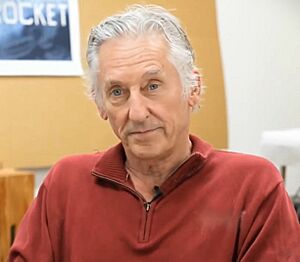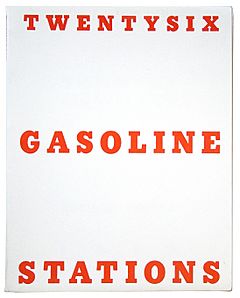Edward Ruscha facts for kids
Quick facts for kids
Edward Ruscha
|
|
|---|---|

Ruscha in 2016
|
|
| Born |
Edward Joseph Ruscha IV
December 16, 1937 Omaha, Nebraska, U.S.
|
| Education | Chouinard Art Institute |
| Known for | Painting, photography, printmaking, film, book art |
|
Notable work
|
|
| Movement | Pop art |
| Spouse(s) |
|
| Awards | Guggenheim Fellowship (1971) |
Edward Joseph Ruscha IV (pronounced roo-SHAY; born December 16, 1937) is an American artist famous for his connection to the Pop art movement. He is best known for his cool, funny paintings and photographs that often feature words and phrases. He has worked with many types of art, including painting, printmaking, drawing, photography, and film. Ruscha lives and works in Culver City, California.
Contents
Early Life and First Steps in Art
Edward Ruscha was born in Omaha, Nebraska. As a kid, he loved cartooning. His family later moved to Oklahoma City. When he was 18, in 1956, he drove to Los Angeles to study art. This road trip across the American West would inspire his art for years to come.
He studied at the Chouinard Art Institute, which is now part of the California Institute of the Arts. After finishing school, he traveled in Europe and then worked as a layout artist for an advertising agency. In the early 1960s, he became a well-known artist in the Los Angeles art scene.
Discovering His Unique Style
Ruscha became famous for art that was clever, simple, and often inspired by everyday life. His work is often linked with Pop Art, which uses images from popular culture like ads and comic books.
The Influence of Los Angeles
The city of Los Angeles had a huge impact on Ruscha's art. The wide-open landscapes, car culture, and the movie industry gave him many of his best ideas.
For his 1966 book Every Building on the Sunset Strip, he took photos of a long stretch of the famous boulevard. He also painted famous landmarks like gas stations. His 1963 painting, Standard Station, Amarillo, Texas, is one of his most recognized works. It shows a gas station at a dramatic angle, making it look powerful and important.
The look of Hollywood movies also inspired him. His painting Large Trademark with Eight Spotlights (1962) looks like the famous 20th Century Fox movie logo. He even painted the word "Hollywood" against a sunset, similar to how the Hollywood Sign looks on the hills.
Paintings That Speak
One of Ruscha's most famous ideas was to use words as the main subject of his paintings. He painted single words like BOSS and HONK, or funny phrases he overheard. He said, "Art has to be something that makes you scratch your head."
In the 1960s, he created "liquid word" paintings. He made words like Adios and Steel look as if they were made of spilled liquid. He also created drawings where words seemed to be made of curling ribbons of paper.
In the 1980s, he began using a special font he invented called "Boy Scout Utility Modern." It has squared-off letters, similar to the Hollywood Sign.
Using Unusual Materials
Ruscha loved to experiment with different materials. Instead of just using paint, he sometimes used things you would find in a kitchen. Over the years, he made art with gunpowder, chocolate syrup, fruit juice, coffee, and even cherry pie filling.
For a project in 1970, he printed words using food like bolognese sauce and caviar. These unusual materials often dried into interesting colors and textures, making his art even more unique.
Famous Art Projects
Besides his paintings, Ruscha is also known for his artist's books, films, and large public artworks.
Artist's Books
Between 1962 and 1978, Ruscha created 16 small, simple books that became very influential. These books had straightforward titles that described exactly what was inside, like:
- Twentysix Gasoline Stations (1963)
- Various Small Fires (1964)
- Some Los Angeles Apartments (1965)
- Nine Swimming Pools and a Broken Glass (1968)
These books showed everyday things in a new way and inspired many other artists.
Public Art and Commissions
Ruscha has created large artworks for public spaces. In 1995, he painted a huge, 360-degree work for the Denver Public Library. He also created murals for museums in San Diego and Miami.
He has been asked to create art for many famous people and companies. He designed a cover for Paul McCartney's album McCartney III in 2020. In 2023, he created the cover art for the Beatles' song "Now and Then."
Exhibitions and Recognition
Ruscha's work has been shown in museums all over the world. In 1962, he was part of a very important show called New Painting of Common Objects. This show, which also included artists like Andy Warhol and Roy Lichtenstein, is considered one of the first Pop Art exhibitions in America.
He has had major solo shows at famous museums like the Museum of Modern Art in New York, the Centre Georges Pompidou in Paris, and the Whitney Museum of American Art. In 2005, he represented the United States at the Venice Biennale, a major international art exhibition. For this, he created Chocolate Room, an entire room where the walls were covered with 360 sheets of paper screen-printed with chocolate.
His art is in the collections of many top museums, including the Los Angeles County Museum of Art and the San Francisco Museum of Modern Art.
Personal Life
Ruscha married Danna Knego in 1967. They have a son, Eddie, and a daughter, Sonny. For many years, Ruscha has owned a home in the California desert near Pioneertown, California, which gives him a quiet place to work and think.
See also
 In Spanish: Edward Ruscha para niños
In Spanish: Edward Ruscha para niños



